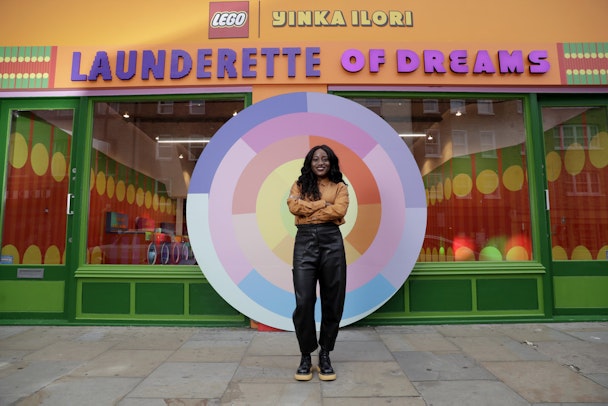Alero Akuya, founder of Nike’s ‘purpose marketing’ division, on shaping Lego’s agenda
Lego’s latest top marketing recruit catches up with The Drum on her first year in the role since leaving Nike.

Lego’s ‘Launderette of Dreams’
Alero Akuya spent more than 12 years at Nike where she ran the sports giant’s athlete marketing strategy and founded the ‘purpose marketing’ division, which was behind the award-winning social justice campaigns featuring Colin Kaepernick, Serena Williams, Kobe Bryant and Kyrie Irving. But in January 2020 Akuya departed to become Lego’s vice-president of global brand, a role that has seen her take on responsibility for the company’s environmental, social and governance (ESG) agenda.
It’s no small task. On the environmental side, Lego has committed £290m over three years into projects that will help to reduce its absolute carbon emissions by 37% by 2032. And then there’s the inescapable fact that the lovable plastic bricks take up to 1,300 years to degrade on the ocean floor – a very real challenge for the brand that has since seen it promise to make all packaging sustainable by 2025 and all products sustainable by 2030.
Akuya has also inherited the ‘Rebuild the World’ campaign that sees everyday places transformed into interactive and vibrant play spaces to inspire children. The latest iteration, a ‘Launderette of Dreams,’ launched in London this week.
She shares the lessons she’s taken from Nike and her top priorities for the year ahead. Answers have been edited for clarity.
What drew you to Lego?
The commonalities between both brands is the level of purpose behind the work that they do. And the commitment that Lego has to children and really elevating their potential is unmatched. But there is a connecting thread between both my past life and my current one: the ‘Power of Play.’ The power of play to change the world, the power of play to inspire people to create things that don’t yet exist, the power to elevate imagination.
It’s been quite the transition. But with the notion of children being our role models, it’s a really fun workplace.
What were some of your biggest achievements at Nike?
My biggest achievements landed two spaces. Firstly, I had the privilege of establishing purpose marketing at Nike, which is now a globally integrated function. I was really proud to leave that legacy. And then the second piece is I had the chance to really accelerate cultural marketing and lead the launch of Nike’s biggest and most successful collaboration with Virgil Abloh.
What lessons will you bring from Nike to help Lego’s purpose marketing?
Yes, a lot of the work has already been well established at Lego. I’m sure you’ve even seen over the last few months some of the work that’s being done around environmental sustainability, inclusivity and access. If anything, what we’re doing right now is just making sure it is a true center focus across all of our brand touchpoints. As I mentioned, a lot of this work is already well under way, so now it’s about building a unified approach in partnership with my colleagues and accelerating the work already in place.
What are some of your priorities to doing that?
The biggest opportunity is continuing this notion of inclusivity and access to our brand and making sure that it’s really accessible to all. Again, I’ll reference some of the stuff that you’ve probably seen over the last few weeks [Lego committed to remove gender bias from its toys and marketing; it launched a children’s guide on how to tackle the climate crisis; and opened the Launderette of Dreams in London] as a representation of where we’re headed. A lot of that work is well under way.
We’re days away from Cop26. How do you ensure that Lego’s purpose strategy really resonates with consumers?
You’re absolutely right – consumers are aware and keen to understand what tangible actions are taken. We hold ourselves accountable internally through a framework of ‘Be, Do, then Say.’ We want to be who we say we are in a world.
Lego has figured it out. It has a pretty strong foundation here that we want to do and really take on the appropriate actions to support what we ultimately will say in the world.
That’s the way we really think about things holistically, so you can take any project and more or less run that through the filter. We’re clear on our mission and our vision. We’re clear on the areas of opportunity, and we just want to hold ourselves accountable.
How do you measure the impact of your ‘purpose marketing’ efforts, which has been a point of debate in the UK this week?
There’s a couple of ways of thinking about it – what are the standard metrics that you can apply depending on what the narrative and the approach might be?
We have to understand what the purpose and objective of the ‘purpose’ work is. Really, when I think about it at the most basic level, do consumers feel reflected in your existing storytelling, your work, your experiences holistically? Can they connect, can they engage, or do they engage with those stories?
At the end of the day, it’s really about captivating the hearts and minds of our consumers and making sure that they can see themselves or feel reflected in the experience, and when you think about the Lego brand purpose specifically, it is really about this agnostic play experience that is meant to be open and inviting. And welcoming people into the brand.

